ABSTRACT
This report is a fire protection engineering analysis of the Maumus Center, a science center and planetarium, in Arabi, Louisiana. The objective of this analysis is to outline the code defined requirements and to confirm the minimum level of safety from fire is attained. Analyzed in the report are the design requirements prescribed in the adopted building and life safety codes, and the performance of the prescribed design.
The prescriptive review addresses the building construction in regards to fire protection, the means of egress, the water‐based fire suppression system, and the fire alarm system. The performance review incorporates the goals and objectives defined by the Life Safety Code, a performance criteria that establishes tenability limits that must not be exceeded, the selection of three realistic and conservative fire scenarios with the potential to affect a large population of occupants, and an analysis of one fire scenario using engineering empirical calculations and computer‐based models to determine the effectiveness of the building fire protection systems.
The prescriptive design satisfies the code requirements; however, there are special situations, regarding the fire sprinkler system, that are not incorporated in the codes. For instance, the Planetarium dome projection screen’s impact on the fire sprinkler system’s activation time and water delivery to a hazard below the screen. Also, the lack of fire sprinkler protection below the telescopic seating system in the auditorium. Both of these applications require further analysis to better determine an adequate solution. The Lobby fire scenario analyzed estimates the building occupants will be unable to safely evacuate the building prior to being exposed to fire effects, more specifically diminished visibility and untenable temperatures. Possible solutions are recommended, but further analysis is required.
PRESCRIPTIVE DESIGN
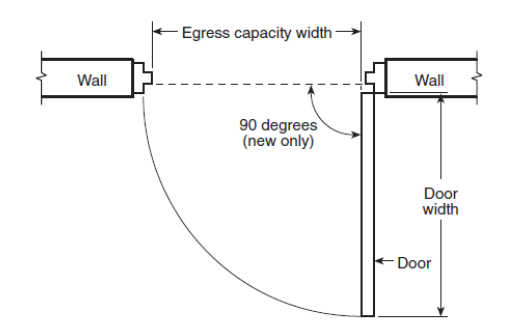
Figure 15 Egress Capacity Width.
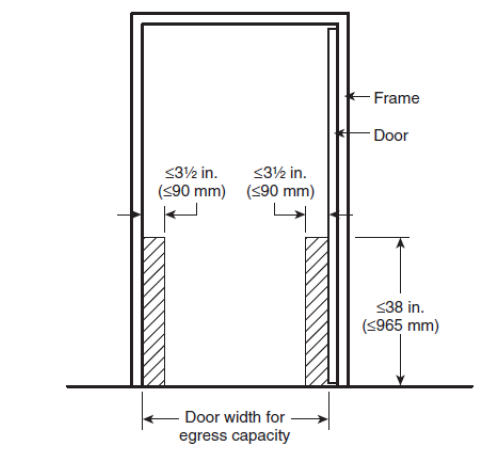
Figure 16 Permitted Door Obstructions.
Door Leaf Width – is an important element of the means of egress, especially when determining the egress capacity of a given doorway. Figures 15 and 16 illustrate where the egress capacity width shall be measured and where the 3½ in. by 38 in. projection allowance is located. The minimum allowable egress capacity width is determined by the required egress capacity, based on the occupant load intended to pass through a door opening, addressed in the Egress Capacity section
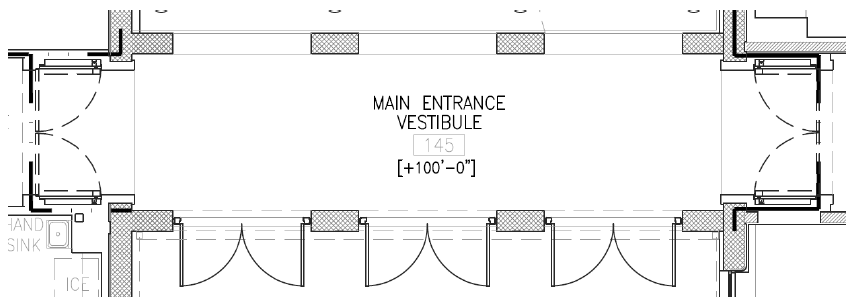
Figure 17 Main Entrance Vestibule – Door Swing.
The Life Safety Plans, found in the Appendix, clearly shows the door swings and the widths of the aisles, corridors, passageways, and landings, confirming the building meets the door swing requirements for the means of egress. Figure 17 is the main entrance vestibule showing the doors swing in the direction of egress travel and the corridor doors are recessed, not projecting into the corridor.
The system piping must be supported from the structure in accordance with Chapter 9. The pipe support and hanger types for the building do not require special applications; therefore, engineered alternatives are not addressed. The hanger components that attach directly to the building structure or to the fire sprinkler pipe must be listed or approved for the intended use, and this is confirmed by referencing the manufacturers equipment datasheet for the attachments. Figure 38 illustrates the typical hangers supporting the sprinkler system.
PERFORMANCE‐BASED DESIGN
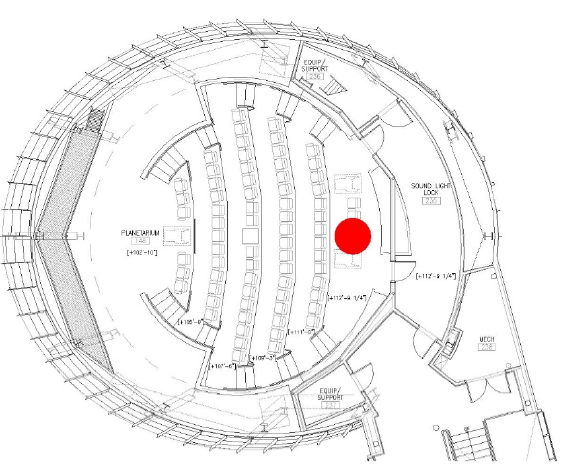
Figure 58 Planetarium Fire Location.
The Planetarium was selected based on the unique use and geometry, more specifically, to simulate how the projection screen influences the fire scenario. Therefore, the location of the fire must be located beneath the screen. The exact location is identified in the Fuel paragraph below and shown in Figure 58.
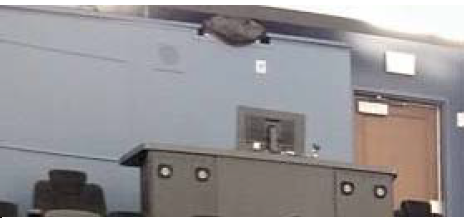
Figure 59 Workstation Image.
he composition of the workstation is not explicitly defined; however, based on the review of an existing image of the workstation, Figure 59, it appears to be constructed of metal, fiberboard lined in a plastic veneer, and trimmed in plastic. Along with construction of the console, the contents of the workstation must be considered. The contents include a computer, a monitor, a keyboard, cables, and a possible control board.
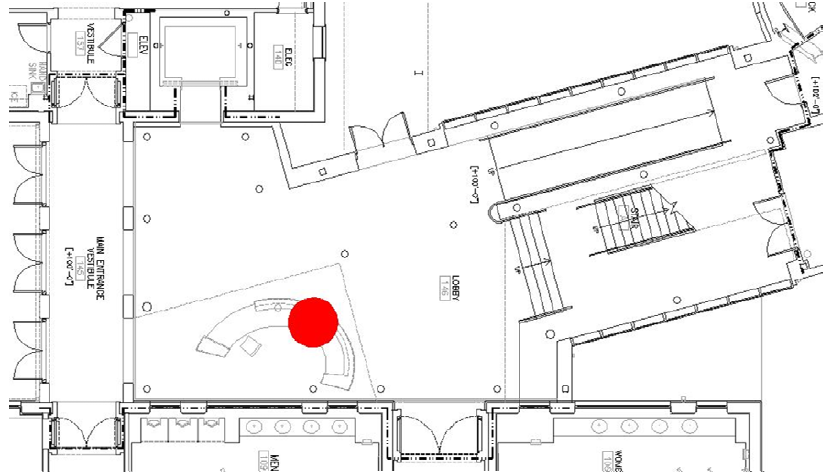
Figure 60 Lobby Fire Location.
Location of Fire – Considering the space is primarily used for egress and standing room only, the permanent entry desk is the most likely fuel source for this fire scenario, and is located as shown in Figure 60. The desk consists of multiple storage compartments and has data and power integrated into the desk construction. Items stored in the compartments, an electrical failure, or the presence of a small trash bin are potential ignition sources.

Figure 74 FDS Temperature – 210 s.
To continue, beyond the visibility threshold the temperature, heat flux, and carbon monoxide levels were evaluated for a duration of 300 seconds. The heat flux and the carbon monoxide levels never reached the tenability threshold defined. However, the temperature of 140°F is exceeded on the 2nd floor of the Lobby at approximately 210 seconds after ignition; hence, the ASET in regards to temperature is exceeded by the Lobby RSET 3 seconds prior to the visibility threshold being reached. The temperature profile at 210 seconds is shown in Figure 74.
CONCLUSION
Concluding Summary
The Maumus Center’s fire protection prescriptive design satisfies the adopted codes and standards. However, there are design situations that are not addressed in the codes or standards, that may have negative consequences for the building and the occupants. Along with these situations, the performance analysis proved the building design has the potential to expose occupants to untenable conditions. The following recommendations address these shortcomings and provide possible solutions that may require further analysis.
Recommendations
The following are recommendations based on the prescriptive and performance‐based analysis:
- The hydrant flow test was performed at 12:30 pm. This time is acceptable per NFPA 291. Although, it is recommended that the test be performed at a more conservative time; either, early in the morning or later in the evening when there is statistically higher water consumption.
- The domed projector screen in the Planetarium is likely to have a negative effect on the fire sprinkler system, if a fire were to originate beneath it. It is recommended that a performance analysis be performed to determine how the system may be negatively affected and what design revisions are required to provide an acceptable level of safety.
- The telescopic seating, in the Auditorium, creates a combustible concealed space with partial and potentially ineffective fire sprinkler protection. It is recommended that a performance analysis be performed to determine how the system may be negatively affected and what design revisions are required to provide an acceptable level of safety.
- The fire sprinkler system Design Area 1, has a length along the branch lines of 64’‐6”. The required minimum length for the 1500 ft.2 design area is 47’‐0”, per NFPA 13. It is recommended to modify the design area by shortening the length closer to 47’‐0”, while maintaining the 1500 ft.2. This modification to the design area may or may not have a negative effect on the hydraulic demand.
- The analysis of the voice evacuation system proved that the speaker spacing may not be capable of achieving intelligibility. It is recommended that a computer‐based audibility model be used to evaluate the performance of the speaker arrangement, additional speakers should be installed, or other applicable speakers with specific performance capabilities should be considered.
- The fire alarm system control unit is located in the Cafeteria, a remote corner of the building. Because of the complex building layout, it is recommended that the control unit be relocated to the Lobby near the main entrance. This placement is a more centralized location along the main path of egress providing increased accessibility to staff and occupants in an emergency scenario.
- The Lobby design scenario proved to have the potential to expose occupants to untenable conditions. It is recommended that further analysis of this scenario be performed to determine suitable design revisions or administrative controls that would improve the outcome for the building occupants.
Source: California Polytechnic State University
Authors: Tyler Mobley
